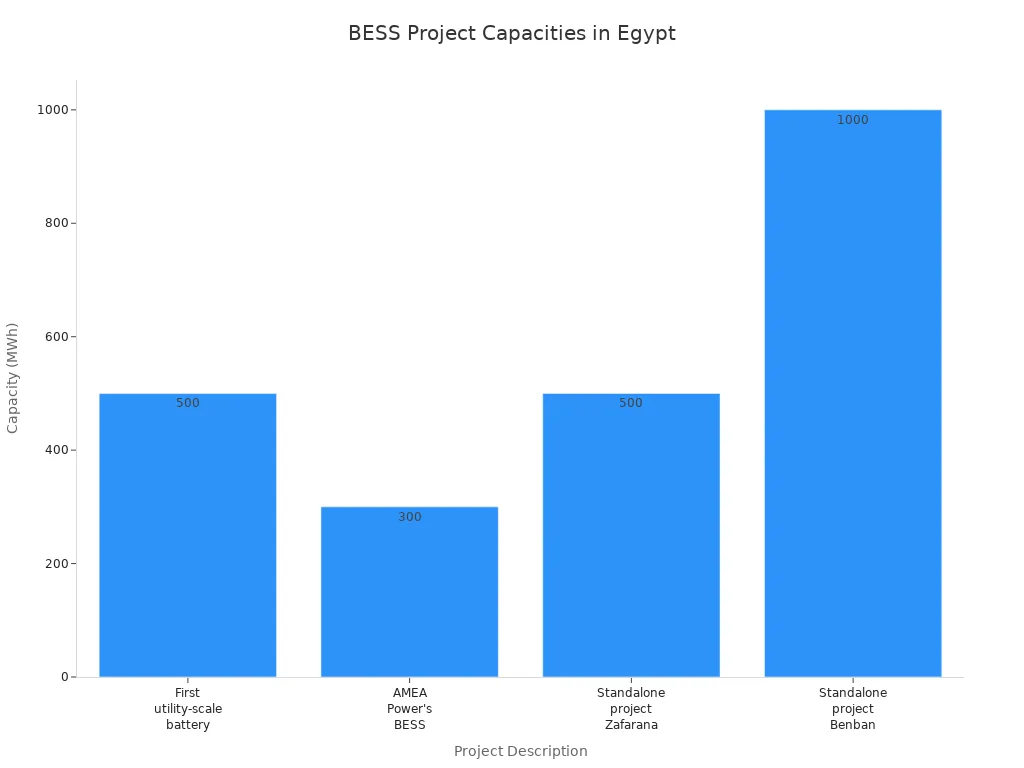
Egypt is witnessing a surge in renewable energy projects, with solar power playing a significant role. The Benban Solar Park spans 37 square kilometers, showcasing Egypt’s commitment to harnessing solar energy. It has the capacity to generate nearly 1.5 GW of power. This expansion is driving the development of Battery Energy Storage Systems (BESS), which are crucial for maintaining a stable energy supply. However, investing in these systems comes with potential fire risks, including electrical fire hazards and thermal runaway. Therefore, proactive fire suppression measures are essential. Advanced solutions such as the Gas Extinguishing Release Control System are vital for safeguarding your assets and ensuring the safety of all personnel.

Key Takeaways
Thermal runaway in lithium-ion batteries can cause big fires and explosions. It is important to understand this risk for anyone using Battery Energy Storage Systems (BESS).
Regular fire safety methods often do not work with lithium-ion batteries. Proactive fire suppression systems are needed to stop fires before they begin.
Finding fires early is very important. Using advanced battery management systems and good cooling can help stop overheating and thermal runaway.
The Gas Extinguishing Release Control System can quickly activate and use cooling agents to control fires fast. This protects both assets and people.
Working with fire safety experts can improve your fire safety plan. They offer special solutions and ongoing help to make sure you stay safe and follow the rules.
Understanding the Unique Threat of Thermal Runaway

The Root Cause: Thermal Runaway
Thermal runaway happens when a lithium-ion battery gets too hot very quickly. This can cause serious problems, like fires and explosions. Many things can cause thermal runaway:
Short circuits inside the battery
Charging the battery too much
Discharging the battery
Heat from outside sources
Breakdown of the battery’s electrolyte
Poor battery management systems
Old batteries
In 2024, the aviation industry saw about two thermal runaway cases each week. This shows the ongoing dangers of lithium-ion batteries. Even though this number is a little lower than in 2023, it is still high. Importantly, 18% of passenger flights with onboard issues lead to big problems, like needing to land somewhere else or emergency evacuations.
Why It’s A Unique Threat in BESS
Thermal runaway is a special danger in Battery Energy Storage Systems (BESS) for a few reasons:
The small and connected design of BESS can cause many failures at once.
Lithium-ion batteries have a lot of power and often charge and discharge, making them more likely to overheat.
The thermal runaway process can create flammable gases, which can lead to explosions that are not usually seen with other fire risks.
These features make thermal runaway very risky. It can cause fires and explosions that are hard to control, threatening both buildings and people. The flammable gases released during thermal runaway can create dangerous conditions inside BESS enclosures. Recent events with lithium-ion batteries show these risks. For instance, a fire in South Korea killed 22 people and hurt many others when one battery cell caught fire and spread to 35,000 cells.
Knowing these dangers is important for anyone managing or using BESS. Using proactive fire suppression methods can help reduce these risks and protect important assets.
Why Conventional Fire Safety is Not Enough

The Ineffectiveness of Traditional Methods
Traditional fire safety methods do not work well for lithium-ion battery cabinets. Here are some problems:
Storage System Design: Bad ventilation or cooling can increase fire risks.
Battery Management Systems (BMS): Problems in BMS can cause thermal runaway, raising fire chances.
Integration with Fire Suppression Systems: Many systems do not have good fire suppression, risking bigger incidents.
Fire Spread in Large-Scale Systems: Fires can quickly spread between connected battery cells, making it hard to control.
These problems show the need for better solutions that fit the unique issues of lithium-ion batteries.
The Dangers of a “Reactive” Approach
Relying only on reactive fire safety can lead to serious problems. A reactive approach waits for incidents to happen, which can raise costs and safety risks. Here are some possible results of this approach:
Consequence Type | Description |
|---|---|
Asset Damage | Fires can ruin or destroy expensive equipment, leading to high replacement costs. |
Operational Downtime | Fire incidents can stop work for weeks or months, hurting profits and returns. |
Increased Insurance Costs | Investors and insurers may look more closely at portfolios, causing costs to rise. |
Regulatory Scrutiny | Many fire events can lead to stricter rules and safety checks. |
Public Perception | Big incidents can reduce trust in energy storage, slowing down industry growth. |
Development Delays | Safety standard reviews can create stricter codes, delaying projects and raising costs. |
Current fire suppression systems often focus on stopping fires instead of preventing them. They do not deal with thermal risks ahead of time. You need complete solutions to handle fire risks in Battery Energy Storage Systems (BESS). Proactive measures include advanced safety features in battery systems that stop critical failures, like overcurrent and overvoltage. These features are part of a larger plan to improve safety and reliability.
In contrast, traditional methods like water or foam do not work well against lithium-ion battery fires because of thermal runaway and reactions with lithium. For example, the Moss Landing Fire on January 16, 2025, at the Moss Landing Power Plant in California forced 1,200 to 1,700 people to evacuate and released toxic smoke. This event shows the urgent need to move from reactive to proactive fire safety measures.
By knowing these dangers and problems, you can see why it is important to use proactive fire suppression strategies to protect your assets and ensure safety.
The Smart Solution: A Proactive, Intelligent Approach
When dealing with the special problems of lithium-ion batteries, you need a smart fire suppression plan. This plan focuses on finding fires early and acting fast to lower risks from thermal runaway and electrical fires. By using advanced technology, you can make Battery Energy Storage Systems (BESS) much safer.
Early Detection is Critical
Finding fires early is very important to stop them. You can use different advanced technologies to spot dangers before they get worse:
Robust Battery Management System (BMS): This system checks battery health all the time. It can turn off the system to stop overheating, which lowers the chance of thermal runaway.
Effective Cooling Systems: These systems are key to stopping batteries from getting too hot, especially in big setups. They help keep the right temperatures.
Fire Detection and Suppression Systems: These systems can find fires early and turn on automatically to control them. This quick action is vital to stop small problems from turning into big ones.
Recent studies show that current fire safety rules in aviation do not work well for lithium-ion battery storage. This shows the need for combined fire detection and suppression systems made for these situations. By using these technologies, you can make your BESS safer.
The Power of the Gas Extinguishing Release Control System
The Gas Extinguishing Release Control System is a key part of Smart fire suppression plan. This system has many benefits:
Immediate Activation: The system has special fire extinguishers that turn on when a fire is found. This fast response helps control the fire well.
Cooling Agents: It uses cooling agents to take away heat from battery cells. This helps stop the fire from spreading and reduces damage.
Automated Response: The system can start fire-fighting actions right away, making sure you deal with dangers quickly.
By using the Gas Extinguishing Release Control System, you can greatly lower the chance of serious failures in your BESS. This system not only protects your assets but also keeps the people safe who work in and around these places.
Complementary Fire Suppression Methods
Along with the Gas Extinguishing Release Control System, you should think about other fire suppression methods to boost safety. These methods include:
Lithium-ion Active Fire Suppression Series: This series has special fire extinguishers and blankets that turn on during a fire. They effectively control the fire and stop it from getting worse.
Lithium-ion Passive Fire Suppression Series: This series includes automatic devices that act at the first signs of fire. They cool and stop the fire source, preventing it from growing.
Also, immersion cooling fluids help by surrounding battery cells. They take away oxygen and put out flames, quickly isolating failing cells. This method greatly improves BESS safety by stopping failures that could cause serious thermal events.
By mixing these advanced fire suppression methods, you can build a complete safety plan that deals with the special risks of lithium-ion batteries. This proactive approach not only protects your investments but also creates a safer workplace.
Implementing a Fire Safety Plan in the Egyptian Context
Risk Assessment and Local Regulations
To make a good fire safety plan for Battery Energy Storage Systems (BESS) in Egypt, start with a careful risk assessment. This assessment finds possible dangers in your facility. Follow these steps:
Evaluate the Environment: Check the layout and nearby areas. Look for flammable materials and things that could start a fire.
Understand Local Regulations: Learn about Egyptian fire safety laws and rules. Following these rules is important for safety and insurance.
Identify Fire Risks: Pay attention to risks linked to lithium-ion batteries, like thermal runaway and electrical fires.
Also, think about the insurance needs for fire safety in BESS projects. Insurers often look for features like space between containers and explosion relief systems. These systems must follow NFPA standards and keep enough distance between containers to avoid extra damage.
The Value of a Strategic Partnership
Working with a trusted fire safety provider can greatly improve your fire safety plan. A strategic partnership has many benefits:
Expertise: Teaming up with experts helps you use the best fire safety practices. They can help you choose the right fire suppression systems, like the Gas Extinguishing Release Control System.
Customized Solutions: A good partner will create solutions just for you. They can help you mix different fire suppression methods, like gas and water protection.
Ongoing Support: Your partner should give you ongoing help, including training for your staff and regular system checks. This keeps your fire safety measures working well over time.
By investing in a strategic partnership, you not only improve your fire safety but also meet changing standards. This proactive approach can help you avoid expensive problems and make your BESS facility safer overall.
In conclusion, Battery Energy Storage Systems (BESS) have special fire risks, especially from thermal runaway. This can happen without any flames, causing fires to grow quickly and create explosion dangers. Regular fire safety methods often do not work well, missing these specific problems.
You need a smart fire suppression plan to keep your assets safe. These systems use advanced monitoring and thermal sensors to find dangers early. By choosing these solutions, you protect your work and help your project’s success in the long run.
To learn more, or to discuss a solution tailored to your specific needs, feel free to contact the TYEE team today.
FAQ
What is thermal runaway in lithium-ion batteries?
Thermal runaway happens when a lithium-ion battery gets too hot. This can cause fires or explosions. Things like short circuits, overcharging, and heat from outside can start this dangerous problem.
How can I prevent thermal runaway in my BESS?
You can stop thermal runaway by using strong battery management systems. Good cooling solutions and early fire detection systems are also important. Regular checks and maintenance are key to keeping everything safe.
Why are traditional fire suppression methods ineffective for lithium-ion batteries?
Traditional methods, like water or foam, usually do not work well on lithium-ion fires. These methods do not fix thermal runaway and can make things worse by reacting with lithium.
What is the Gas Extinguishing Release Control System?
The Gas Extinguishing Release Control System is a smart fire suppression solution. It turns on automatically when it finds a fire. It uses cooling agents to control and put out flames effectively.
How can I ensure compliance with local fire safety regulations?
To stay compliant, do a careful risk assessment and learn about local fire safety laws. Working with a fire safety expert can help you put the right measures in place effectively.









